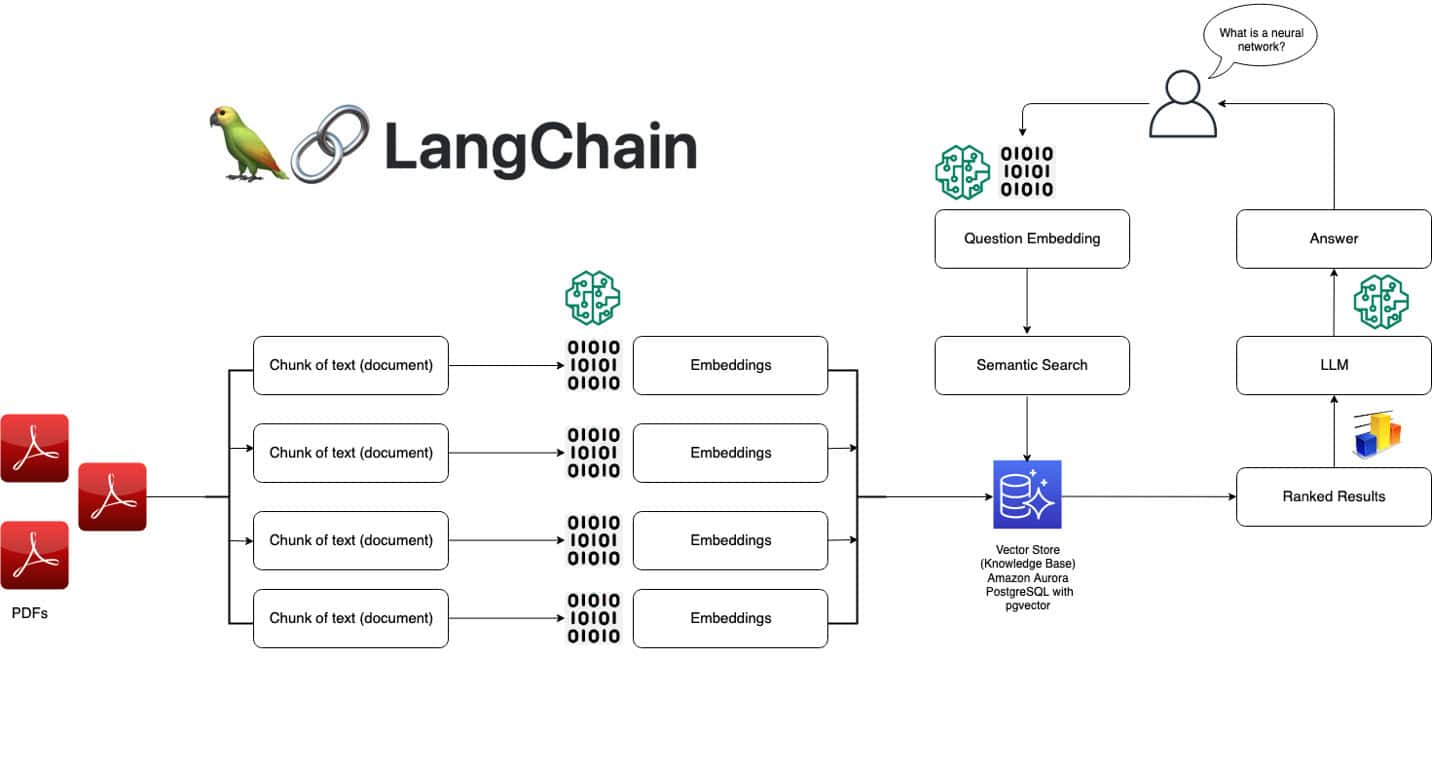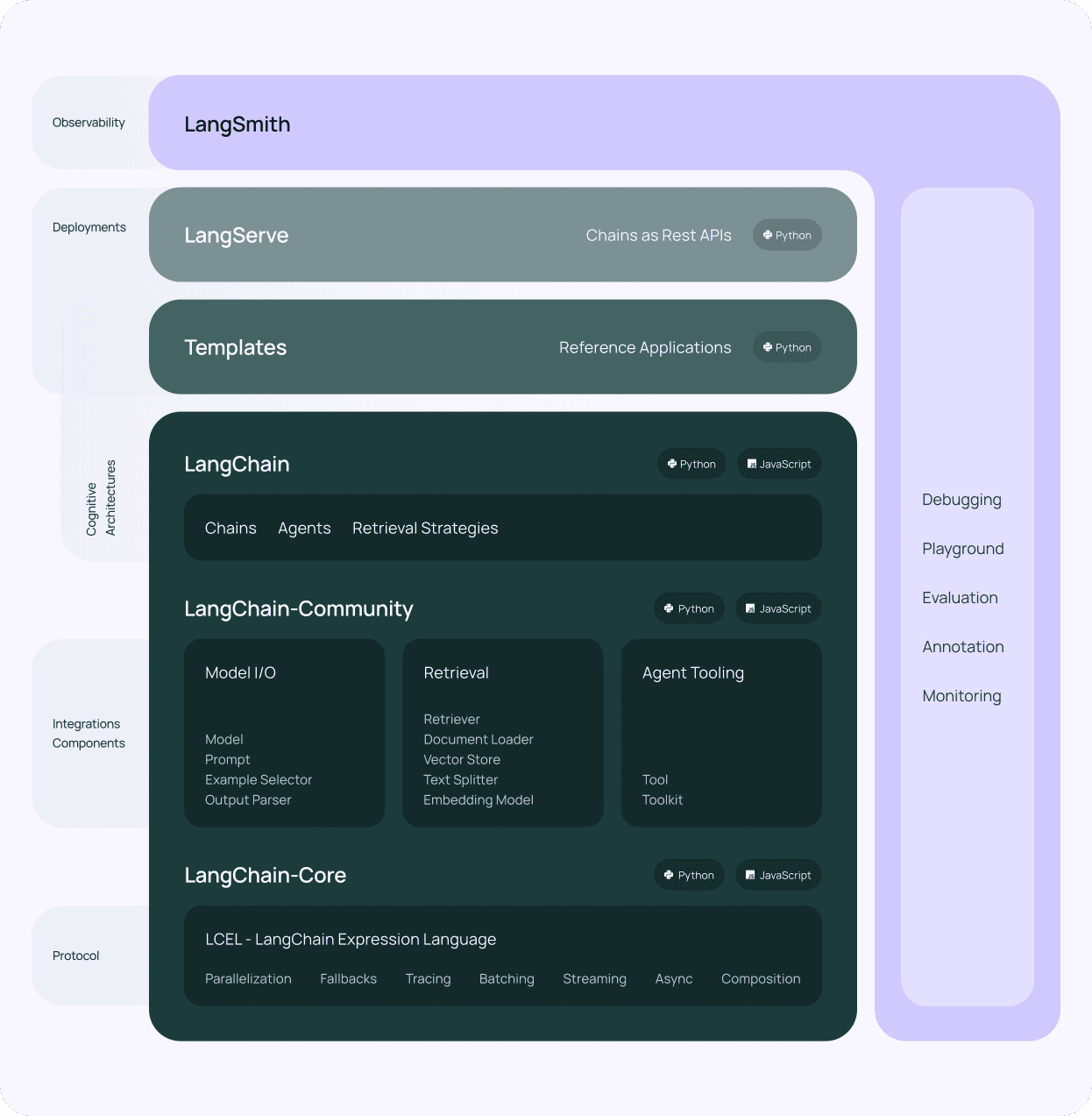What is LangChain? + How Can I use it for Enterprise AI?
For today’s businesses and entrepreneurs, there is an absolute necessity to leverage large language models (LLMs) for enterprise AI applications. These powerful models, trained on vast amounts of data, have the potential to transform how businesses operate and engage with customers. However, integrating LLMs into enterprise workflows can be challenging, often requiring custom integrations with multiple data sources and systems.
Enter LangChain – a framework that simplifies the process of composing language models with external data to build powerful applications. Exploding in popularity over the past few months given the rise of AI chatbots and talk about AI agents and agentic workflows, LangChain provides a generic interface for connecting LLMs with structured data, documents, and APIs, making it easier than ever to create end-to-end agents that can understand and interact with enterprise knowledge.
What is LangChain?
LangChain is a groundbreaking framework that empowers developers to build powerful applications by harnessing the capabilities of large language models. At its core, LangChain enables the seamless integration of language models with external data sources, unlocking a world of possibilities for leveraging the power of these cutting-edge AI systems.
One of the key strengths of LangChain lies in its ability to augment language models with retrieval capabilities. This approach, known as retrieval augmented generation (RAG), allows language models to access and incorporate relevant information from external data sources, such as databases, APIs, or document repositories. By combining the language model’s natural language understanding and generation abilities with access to external knowledge, LangChain opens up new frontiers for building intelligent and context-aware applications for your enterprise.

Key Features of LangChain
Retrieval Augmented Generation for Language Models: LangChain’s retrieval augmented generation feature enables language models to leverage external data sources, enhancing their knowledge and providing more accurate and informed responses. This feature is particularly valuable for applications that require access to up-to-date or specialized information.
Composable Chains for Complex Workflows: LangChain allows developers to create complex workflows by composing reusable chains. These chains can encapsulate a series of operations, such as data retrieval, processing, and generation, enabling the development of sophisticated applications with relative ease. This modular approach promotes code reusability and maintainability.
Off-the-Shelf Agents and Chains: LangChain provides a collection of pre-built agents and chains that can be readily incorporated into applications. These off-the-shelf components cover a wide range of use cases, including question-answering, code generation, and data analysis, accelerating the development process and allowing developers to focus on higher-level tasks.
Support for Various Data Formats: LangChain offers built-in support for a multitude of data formats, including plain text, PDFs, images, and structured data sources like databases and APIs. This versatility allows developers to seamlessly integrate their applications with diverse information sources, enabling the creation of comprehensive and data-driven solutions.
By leveraging these key features, LangChain empowers developers to build powerful enterprise AI applications that can leverage the full potential of large language models, while seamlessly integrating with external data sources and complex workflows.
How LangChain Works Under the Hood
LangChain’s modular architecture lies at the heart of its power and flexibility. By breaking down complex workflows into reusable components, LangChain enables developers to compose intricate chains that can seamlessly integrate language models with external data sources and custom logic.
At the core of LangChain’s architecture are agents, tools, memory, and chains. Agents act as the orchestrators, determining which tools to utilize and how to combine their outputs to achieve the desired result. Tools, on the other hand, are the building blocks that perform specific tasks, such as querying databases, making API calls, or applying language models for generation or analysis.
The memory component plays a crucial role in maintaining context and state across different steps of a chain, enabling agents to make informed decisions based on previous interactions or retrieved information. This is particularly valuable for applications that require long-term memory or context awareness.
Chains are the glue that binds agents, tools, and memory together, defining the sequence of operations and the flow of data between them. LangChain provides a rich set of pre-built chains for common use cases, such as question-answering, code generation, and data analysis, while also allowing developers to create custom chains tailored to their specific needs.
To illustrate a typical workflow, consider a question-answering application built with LangChain. When a user submits a query, an agent is invoked to orchestrate the process. The agent may first call a tool to retrieve relevant documents from a database or document repository. These documents are then passed to a language model, which generates a candidate answer. The agent can then evaluate the answer’s quality, potentially iterating or refining the process by incorporating additional tools or memory components.
One of the key strengths of LangChain is its extensibility and customization capabilities. Developers can create custom agents and tools to encapsulate domain-specific logic or integrate with proprietary systems. This flexibility ensures that LangChain can adapt to the unique requirements of enterprise environments, enabling the development of tailored solutions that leverage the full potential of large language models in conjunction with structured data and business-specific rules.

Why LangChain for Enterprises?
In today’s data-driven landscape, enterprises are increasingly seeking ways to unlock the transformative potential of artificial intelligence, particularly large language models. However, integrating these powerful models with complex business processes and structured data sources can be a daunting challenge. This is where LangChain emerges as a game-changer for enterprises, offering a robust framework that bridges the gap between language models and the intricate world of enterprise data and workflows.
1. Unlock Language Models’ Potential with Structured Data Access
LangChain’s retrieval augmented generation capabilities enable language models to seamlessly access and incorporate information from diverse structured data sources, such as databases, APIs, and document repositories. This fusion of natural language processing and structured data access empowers enterprises to leverage the full potential of language models while ensuring that their outputs are grounded in accurate, up-to-date, and relevant information.
2. Leverage Up-to-Date Knowledge and Information
In fast-paced business environments, access to the latest information is paramount. LangChain’s ability to integrate with live data sources ensures that language model outputs are informed by the most current data available, minimizing the risk of outdated or stale information hampering decision-making processes.
3. Streamline Development of Enterprise AI Applications
Building enterprise-grade AI applications from scratch can be a complex and time-consuming endeavor. LangChain’s modular architecture, composable chains, and off-the-shelf agents and tools significantly accelerate the development process, enabling enterprises to rapidly prototype and deploy intelligent solutions tailored to their specific needs.
4. Boost Productivity with Reusable Components
LangChain’s emphasis on reusability and modularity translates into tangible productivity gains for enterprise development teams. By leveraging pre-built components and encapsulating business logic into reusable agents and tools, enterprises can optimize development efforts, reduce technical debt, and foster collaboration across teams.
5. Built-in Tools and Utilities
LangChain’s comprehensive set of built-in tools and utilities further amplifies its value proposition for enterprises. These tools encompass a wide range of functionalities, including text splitters, vector stores, and embeddings, enabling efficient data processing and seamless interaction with language models.
By leveraging LangChain’s built-in functionality, enterprises can streamline their data pipelines, extracting insights from unstructured data sources, and creating robust applications that can handle diverse data formats and large volumes of information with ease.
LangChain Plays a Big Role in Today’s Enterprise AI
LangChain represents a significant leap forward in the realm of enterprise AI, empowering organizations to harness the full potential of large language models while seamlessly integrating them with structured data sources and complex business workflows. By providing a robust framework that bridges the gap between cutting-edge natural language processing capabilities and the intricacies of enterprise data and processes, LangChain opens up new avenues for innovation and digital transformation.
The future of enterprise AI is inextricably tied to the ability to seamlessly integrate language models with enterprise data and domain-specific knowledge. By embracing LangChain, your enterprise can position itself at the forefront of competition, fostering an environment where intelligent systems work with human expertise, driving efficiency, innovation, and growth.






